Citation:
Cai, K. †; Xie, J. †; Zhang, D. ; Shi, W. ; Yan, Q. *; Zhao, D. *. Concurrent Cooperative J-Aggregates and Anticooperative H-Aggregates. J. Am. Chem. Soc. 2018, 140, 5764-5773.
摘要:
Completely understanding the working mechanisms of sophisticated supramolecular self-assembly exhibiting competing paths is very important for chemists en route to acquiring the ability of constructing supramolecular systems with controlled structures and designed functions. Here, the self-aggregation behaviors of an N-heterocyclic aromatic dicarboximide molecule 1, boasting two competing paths that give rise to different supramolecular structures and exhibit distinct thermodynamic features, are carefully examined. First, a group of H-aggregates are observed when providing a medium driving force for aromatic stacking, and their formation is manifested as an anticooperative process. When exposed to enhanced strength of aromatic interactions, these H-aggregates are found to transform into J-aggregates via a cooperative assembly mechanism. With the assistance of a mathematic model accommodating two competing polymerization pathways, calculations are conducted to simulate and explain the thermodynamic equilibria of such a unique supramolecular system. The calculation results are highly consistent with the experimental observations, and some important properties are elucidated. Specifically, the anticooperative assembly mechanism generally promotes the formation of low to medium oligomers, whereas the cooperative path is more competent at producing high polymers. If the anticooperative and cooperative routes coexist and compete for the same molecule, the cooperative formations of high polymers are significantly suppressed unless a very high degree of polymerization can be achieved. Such a unique feature of concurring anticooperative and cooperative paths emerges to the H- and J-aggregates of molecule 1 and thus brings about the interesting sequential appearances of the two types of aggregates under conditions of continuously enlarged driving force for self-aggregation. Finally, based on the knowledge acquired from this study and by analyzing the steric features of 1 that influence its supramolecular packing motifs, a slightly modified molecular structure is designed, with which the intermediate H-aggregation state was successfully suppressed, and a single cooperative J-aggregation path is manifested.See also: 2018
